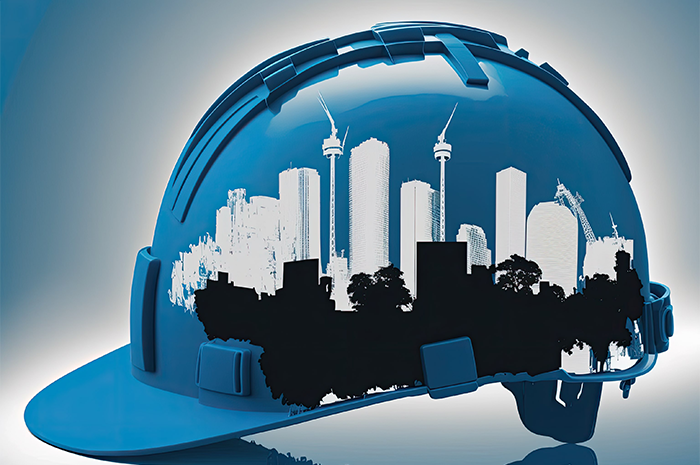Aldous Huxley, in his seminal novel “Brave New World”, described a dystopian future where communal activity and conformity to a caste system were valued above all else. If one didn’t take part in approved activities, that person was viewed as an outcast and a trouble maker.
In our new world of rapidly-evolving technology, small architecture and construction firms who haven’t adopted Building Information Modeling (BIM) are definitely feeling a similar pressure to conform. Citizens in Huxley’s World State were subjected to consumption conditioning in their sleep.
While BIM hasn’t been inserted into our sleep cycle yet, we’re definitely being subjected to BIM conditioning in our waking moments. In trade publications and webzines, in conferences and presentations and trade association meetings, even in collegial shop talk, it is all about BIM all the time. What was once one possible future has now become an inevitable wave sweeping along the entire building industry.
The task of adopting BIM can be very daunting for a small firm. In a difficult economy, small firms tend to concentrate more on their core competencies – what they know and how they’ve done it in the past – to get by.
Resources, like money, time and in-house Information Technology (IT) expertise, are scarce at smaller firms. Change itself can be unsettling, and the team members may be skeptical of new methodologies. The time and investment needed to implement BIM can seem risky and costly.
So why do it? First, there will likely be negative consequences for not doing it. Small firms who don’t conform are facing the prospect of missing out on a way to survive and thrive, especially as building owners in the municipal, academic, health care, and institutional segments move towards BIM requirements for new buildings and substantial renovations.
Second, there are opportunities to improve your own practices. BIM offers the potential to work smarter and more collaboratively, with fewer mistakes. I won’t say faster, as you may not see improvements in time right away. Third, the technology is evolving to have a democratizing effect on the design industry.
Despite initially being a market differentiators between large and small firms, BIM can be used to reduce the perceived capability gap between firms of different sizes. A great team at a small firm, coupled with the right technology, can take on larger, more complex projects, and possibly compete with larger firms for commissions that used to be out of reach.
So where does one start with BIM implementation? Despite being written about on a large scale, BIM is actually practiced on a more fragmented and disparate scale when it comes to smaller architecture and construction firms.
Sure, the term BIM has been around for awhile, but in practice, BIM is still in its infancy and is still weighted heavily towards the front end of building design and construction. Much of the BIM legwork to date has been pioneered by larger firms and academic researchers.
The high-level strategies of BIM can be easily agreed upon, but the practical application varies quite a bit. Generally-accepted processes are still being developed. There is no set guide on how to implement BIM. If you chafe under the imposition of BIM, take heart in knowing that you still have the creative freedom to forge a path forward that is best suited to your firm and its skill sets.
For the rest of this article, I will detail some challenges posed by BIM implementation and ways for small firms to overcome those challenges. These tips will mostly apply to the practical application of BIM, an area I find very under-documented relative to the large amount of documentation about the high-level aspirations of BIM.
Some of these tips are things we’ve done, some are things I wish we’d done, and some are things we haven’t done yet but make too much sense not to do them when the opportunity arises.
Initial Buy-in
Your firm principals definitely need to support the movement to BIM. The time and costs will be significant, and at times costs may be more than anticipated.
The principals are taking a leap of faith it will pay off eventually, if not necessarily with more commissions, then at least with a firm that is more agile, collaborates better, and makes better buildings. Even if the principals don’t lead the adoption effort, they need to solidly be behind the architect, project manager, or CAD manager who is tasked with BIM implementation.
In addition, the staff should also support the process. The advantages of BIM are varied, sundry and well-documented. The staff should be made aware of those advantages and also have clear understanding of your firm’s BIM goals. One goal could be reducing the number of construction mistakes during a project. How this will be accomplished may not yet be set in stone, but knowing the goal will help team members work towards developing processes appropriate to achieving that goal.
Contractual Issues
One hindrance to BIM adoption may be an unwillingness by consultants and contractors to trust a digital model and its accompanying data versus paper documents. Some of these concerns can be assuaged through the Integrated Project Delivery (IPD) model.
Risk associated with the BIM model can be shared among participants throughout the design and construction process, thus alleviating the problem of one group assuming all of the liability for a mistake in the BIM model.
Like IPD, BIM works best when design and construction team members are collaborating early and often. The American Institute of Architects has developed a guide and contract documents for IPD that are well-suited to BIM processes. You can find them on the AIA website. The legal reasoning and ramifications are explained well.
Tools
The most publicized and talked-about aspect of BIM is the tools. A challenge to small firms is the hard cost of investing in the software tools needed for running a BIM project. There is a lot of emphasis on the 3D modeling tools like Revit, ArchiCAD, Bentley Microstation, and Vectorworks. To determine which tool you should use, talk to your consultants, contractors, and architectural colleagues to see which tools they prefer. There is no single tool that can handle all aspects of BIM, so make sure the tools you use are capable of creating output in a format that is useable in other software tools, especially those used downstream from you.You may also need software or networking assistance to share data, such as your BIM building models, through a web-based site. Think about a site that ties in mobile, use the enterprise-strength cloud-based Construction App from Procore.
These applications can be quite expensive, and there isn’t really a way around that. You are better off dealing with your preferred software vendors to purchase multiple applications in a bundle versus stand-alone, single-seat licenses from an online source like Amazon.com. Your resellers can give you better deals on software bundles, and they can also offer training and technical support to you. Negotiate for as much free training and support as you can get.
These programs require significant computing power. You may need to upgrade your computer systems in addition to buying the software. Buying new computers is the most cost-effective method if you have the cash on hand; if not, leasing is a way to get a new computer with little money down. Some software manufacturers are offering more services in a ‘cloud’ format. For example, Autodesk now offers a service where you can render your scenes using their rendering farms in a computing cloud. Using these services can reduce your need for the highest-performance computing hardware.
Another challenge is trying to figure out what other programs you’ll need besides a CAD program that supports BIM workflows. Database programs, or at least plug-ins that support the exchange of data between the BIM model and a spreadsheet, are very useful. Databases can help add functionality beyond the design and specification of building components.
You can add data to the building for cost estimating, sequencing, purchasing, and construction. You may also need software or networking assistance to share data, such as your BIM building models, through a web-based site.
One final tool I’ll note is for renovation work. If you are looking at renovation work, you may be able to take advantage of BIM tools to decrease the time needed for field measuring and modeling of existing conditions. There is a software package called PKNail Pro, from Pointknown Solutions, that can create a building model in Revit using measurements from a Leica Range Finder. This enables a small firm to create an existing-conditions model much more quickly than through conventional methods.
In-house Implementation
To start, do a pilot project of something recently completed. I don’t recommend doing your first BIM implementation on new or in-process project. If you need to add a staff member with expertise in a BIM tool, check with your local colleges to find recent graduates with proficiency in your BIM tools.
New team members who know current tools but don’t know much about design and construction can be a good compliment to a staff that knows how to design and build but doesn’t know the latest BIM tools.
Training is a conundrum. Do you pay for it, or try to figure it out yourself? These tools are pretty complex, so you will likely need some training. I advocate training that is as close to your real projects as possible. Some resellers offer training at your site where they guide you through one of your actual projects. I recommend that over generic training at a remote site. Generic training focuses on major functionality, but it doesn’t give you the complete flavor of working through each major aspect of your project from scratch.
A good source for technical help with software is the web. Users have banded together to put lots of great information on the web. The fastest way to get an answer to a problem, or guidance on how to do something you don’t know how to do, is to Google it. Many times you can find your answers on user groups or discussion boards. LinkedIn is another site that hosts online groups; use those to establish relationships with other users who are trying to do the same things you are. There are also lots of free training videos on Youtube; take advantage of them. Share your new-found skills among your team members frequently.
Establishing a BIM Workflow
A recent study found that most firms use BIM only for visualization, architectural design, and clash detection.1 Many BIM advocates will assert that true BIM also encompasses the 4D, 5D, and 6D aspects of time, cost and facility management.
They are absolutely correct, but it’s okay to start small and work your way into more complex BIM workflows. Many building owners currently can’t do much with BIM models anyways, so at first you’ll be concentrating on making better buildings faster and with fewer mistakes.
To determine the scope of your BIM deliverables, talk to your owner, consultants, and contractors. What deliverables do they need? Owners may not have any use for a BIM model.
Consultants may need the model a certain way to take advantage of analysis capabilities. Construction people, especially subcontractors, may also need the model a certain way to help automate detailing and fabrication. Work closely with them to ensure your model is developed in a way that is useful to others without compromising your own deliverable.
I’ve heard of many instances where contractors re-model the deliverables from the architects to suit their purposes. That sounds unfortunate and avoidable. If possible, try to pick consultants who have already done projects with your software tools, and get their feedback on your models so that you’re not introducing redundant efforts.
Own It
In closing, you can help drive the future of BIM. If you are looking for a clear road map of how to deliver a BIM project, you won’t find it.
Be creative and open to new ways of doing things, keeping in mind an over-arching goal of providing as much pertinent information as possible to everyone downstream, from contractors, subcontractors and fabricators, to commissioning agents, facility managers, owners and occupants.
For example, if you can use a database to mark areas or components of the building as punch list items, wouldn’t it be great to push that information into the BIM model so that it’s graphically represented in a 3D building model?
The contractor could pull up the 3D model on his or her laptop or tablet, and see all the punch list items highlighted in red. Nobody can tell you all the ways to utilize BIM. It is truly up to us to make our way in the brave new world.
References: 1. Estimating With Bim: A Survey Of Us Construction Companies Anoop Sattineni* and R. Harrison Bradford II. McWhorter School of Building Science, Auburn University, 2011.







 Architecture and Construction Wearables to Keep an Eye On
Architecture and Construction Wearables to Keep an Eye On  Robots are Real
Robots are Real  The Techie Way or Not? Conserving Heritage Buildings
The Techie Way or Not? Conserving Heritage Buildings  The Evolution of Revit Over AutoCAD: Comparing Features, Challenges & Industry Adoption
The Evolution of Revit Over AutoCAD: Comparing Features, Challenges & Industry Adoption